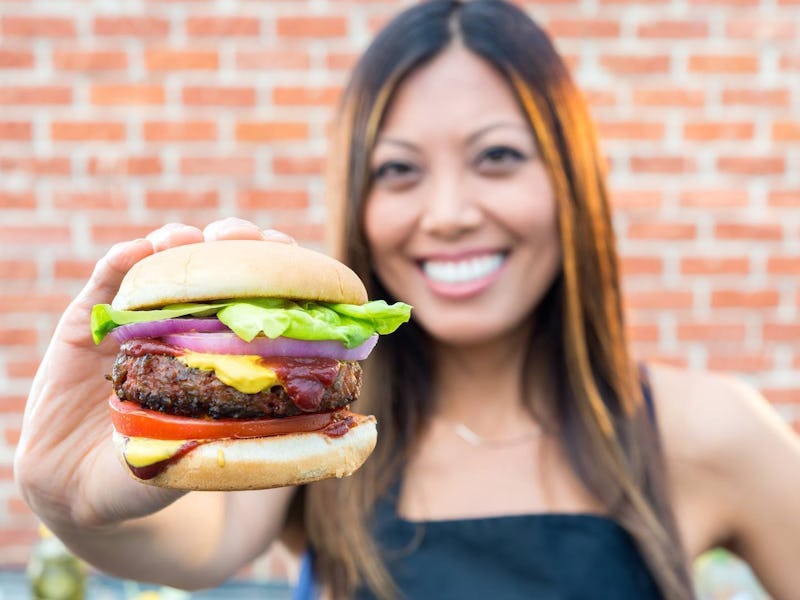As Beyond Meat aims to be the next Tesla, here’s how alt-meat could surge
Alternatives to meat could look very different in years to come.

Ethan Brown, CEO of Beyond Meat, turned heads this week when he announced that his company is going to become the Amazon or Tesla of the meat industry.
“Like, why is Tesla able to do what it does?” Brown told Business Insider on Wednesday. “There is a DNA to certain companies that allow them to get an insight into an industry and get far enough ahead before others catch on. And then the game is to just stretch that lead and continue to play into your strengths.”
It may not offer an online store that offers almost everything, nor does it promise to popularize the electric car, but Beyond Meat’s plant-based burgers could have a major influence on the $1.4 trillion meat industry.
Alternatives to traditional meats — termed “alt-meats” by the New York Times and Fast Company — are on the rise. While plant-based burgers have made a big impact on the market, new foods and even lab-grown meats could take it to all-new levels.
“I don’t think I’ve personally, in a very long career, seen anything quite like this,” Marie Wright, chief global flavorist for Archer Daniels Midland, tells Inverse. “I think it’s exciting and I think it’s necessary. We need other sources of protein, other sources of food, if we’re going to feed the world.”
The world's first lab-grown burger, as held by its creator Mark Post.
Alt-meats: how alternative foods are on the rise
Traditional meat has played a key role in the human diet for thousands of years. Human remains in a cave near Beijing suggest some of the earliest modern humans regularly ate fish 40,000 years ago.
Fast forward 40 millennia and foods that recreate the taste of animal meat are on the rise. Beyond Meat and Impossible Foods, founded in 2009 and 2011 respectively, are both aiming to use plants to recreate the taste of meat. Lab-grown meat, which some experts expect to reach dinner plates in 2021, encourage stem cell growth in a bioreactor to produce more animal tissue and eventually cut the animal from the equation.
Plant-based meats have made a big impact on the market. The Good Food Institute, a non-profit organization that lobbies for alt-meats, released a report in July that found plant-based meat is growing five times faster than animal meats in the American retail space.
While meat experienced growth over the same time period, plant-based meat saw a dramatic surge.
It’s set to rise further. Consultancy firm AT Kearney found in June 2019 that plant-based meat would account for 10 percent of the market by 2025. By 2040, it’s set to account for 25 percent of the market while lab-based meat accounts for 35 percent.
The analysts' projection of global meat consumption over time.
Alt-meats: where they will go from here
The main area where these products will grow is expanding into other areas of meat. Wright explains that new advancements in flavor technology can unlock new alt-foods. Developing a “cleaner” pea protein, for example, could mask its vegetable tastes and enable its use in other products. Beyond Meat uses pea protein, while Impossible Foods uses soy and potato protein. Advancements in flavor can pave the way for new dishes.
“I think we’re going to see an expansion into other products,” Wright says. “Steak. Chicken, which is a much lighter tasting meat. Maybe fish eventually. Fish is a hard one, but chicken certainly.”
Both companies are already expanding their repertoire. Impossible Foods has been experimenting with an anchovy-like broth that could make fish. It’s partnered with Wow Bao to make an Impossible Bao, while Dos Toros is using the firm’s ground beef to create burritos. Beyond Meat has partnered with Subway to create a plant-based meatball sub.
Beyond Meat plant-based meat-like patties.
These new meats may pose problems. Chicken is relatively easy to accomplish, but the use of coconut and palm to simulate chicken fat could pose sustainability and taste issues. Fish is a more complex and harder meat to simulate in terms of taste.
But Wright also notes that foods of the future may not necessarily aim to simply replace meat. It could mix both meat and meat replacements, appealing to flexitarians less concerned with reducing animal consumption. It could experiment with more flavors and spices, appealing to consumer interest in food variety. The race to directly mimic meat products could fade away: Wright notes how China has a long history of using meat alternatives like seitan, which retain the umami flavors of meat.
“At the moment excitement is on the mimicking,” Wright says.
Lab-based meat could transform this area. Researcher Mark Post publicly ate a cultured burger in 2013, a burger that experts at the tasting previously told Inverse resembled a McDonald’s burger.
Ahead of an expected launch in supermarkets over the next two years, researchers have been growing meat in space, developing edible scaffolding, and even experimenting with new meats. Suggested products include kangaroo, bacon, steak, foie gras, seafood, and even combination portions that take cells from multiple animals.
Beef, chicken and lobster steak from IntegriCulture.
Wright suggests, however, that these meats may still require some perfection to attain the feeling of traditional meat.
“Meat as it is today, whether it’s grass-fed, the age,” Wright says. “There’s different flavors associated with that. It’s like wine. If you grow wine in different terroirs, you get different flavors.”
Beyond Meat CEO Ethan Brown’s comparison to Tesla may have raised eyebrows, but it could prove particularly relevant as this area develops. When Tesla launched the Roadster in 2008, it could only travel 240 miles per charge. Its second-generation Roadster, set to launch next year, reaches 620 miles per charge. Similarly, the initial offerings from Beyond Meat and others could pale in comparison to what comes next.
Plant-based meat, a passing fad? The alt-meat industry could just be getting warmed up.